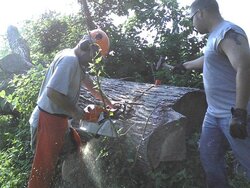So I just read the noodling thread and have a question:
I have used this idea to work on some of my knotty rounds, and will typically cut into the round from the top with my chain saw about 2 inches and then use wedges to wrestle it apart. Do you guys find it easier to cut into the round from the side and then use wedges? I always figured that "wedging" with the grain (from the top) would be easier than against or through the grain (from the side).
Please share your experience and thoughts.
Thanks!
I have used this idea to work on some of my knotty rounds, and will typically cut into the round from the top with my chain saw about 2 inches and then use wedges to wrestle it apart. Do you guys find it easier to cut into the round from the side and then use wedges? I always figured that "wedging" with the grain (from the top) would be easier than against or through the grain (from the side).
Please share your experience and thoughts.
Thanks!


